Considering Mountain Micro-Topographic Characteristics in Habitat Quality Assessments and Its Nonlinear Influencing Mechanism
Abstract
:1. Introduction
2. Materials and Methods
2.1. Study Area
2.2. Data Sources and Preprocessing
2.3. Methods
2.3.1. Geomorphological Types and Micro-Topographic Positions Classification
2.3.2. HQ Assessment
2.3.3. Least-Square Method Trend Analysis
2.3.4. Hotspot Analysis
2.3.5. Distribution Index
2.3.6. Generalized Additive Model
3. Results
3.1. Topographic Features of Mountain City
3.1.1. Landform Type Characteristics of CMC
3.1.2. Mountain Micro-Topographic Analysis of CMC
3.2. Spatiotemporal Change Trend Characteristic of HQ
3.3. Spatiotemporal Heterogeneity Analysis of HQ Hotspots
3.3.1. The Heterogeneity of HQ Hotspots in Different Geomorphological Types
3.3.2. The Heterogeneity of HQ Hotspots in Different Land Use Types
3.4. Nonlinear Influence Effects on HQ
4. Discussion
4.1. Optimal Assessment of HQ Considering Mountain Micro-Topographic Characteristics
4.2. The Analysis of the Spatiotemporal Change in HQ in the CMC
4.3. Nonlinear Influencing Mechanism of HQ Under Complex Landscape City
4.4. Limitations and Future Works
5. Conclusions
- (1)
- The overall HQ in CMC exhibited significant spatial variability. High-value HQ areas were mainly concentrated in mountainous areas such as Jinyun Mountain, Zhongliang Mountain, Tongluo Mountain, and Mingyue Mountain, while the HQ in the urban central areas was lower. From 2000 to 2020, on the one hand, the urbanization process continued to advance, and the interference from human activities continued to increase. On the other hand, ecological protection has been strengthened. While the HQ index level in some areas had decreased, the overall HQ level in CMC had improved. Beibei, Banan, and Yubei districts had the highest average HQ level, while Yuzhong district had the lowest;
- (2)
- HQ hotspots were mainly distributed in parallel mountain areas and ran through the entire study area with a trend from northeast to southwest. Coldspots were mainly distributed in the urban central areas in the central and western parts of the study area. The area of HQ hotspots showed an overall increasing trend, which was mainly due to strict ecological protection work in recent years. With the expansion of construction land, the total area of coldspots had increased rapidly. The HQ hotspots had the highest distribution advantage in mountainous areas, and the distribution index was greater than 2.5, indicating that the mountainous areas were the concentrated distribution areas of HQ hotspots. Specifically, the heterogeneity of HQ at the mountain micro-geomorphology scale was manifested in that the summits were always the hotspots of HQ, with an average distribution index of 2.16. In terms of the composition of land use types, the hotspots and sub-hotspots primarily consisted of forestland, cultivated land, and waters, of which the average proportion of forestland was 87.00% and 54.47%, respectively. Forestland was also a major contributor to HQ hotspots. Over the past two decades, HQ hotspots in forestland have always dominated, accounting for 66.90%, 67.05%, and 58.61%, respectively;
- (3)
- HQ was comprehensively affected by a combination of diverse factors, including natural environmental conditions, socio-economic elements, and the execution of policies. Among them, the NDVI and the distance to forestland had very significant nonlinear relationships with HQ. It was mainly related to the mosaic distribution of long strip parallel mountains and valleys cultivated land in CMC, as well as the complex geomorphologic combination of the anticlinal mountains and the trough valley cultivated land developed on the top.
Author Contributions
Funding
Institutional Review Board Statement
Informed Consent Statement
Data Availability Statement
Conflicts of Interest
References
- Huang, Z.; Bai, Y.; Alatalo, J.M.; Yang, Z. Mapping biodiversity conservation priorities for protected areas: A case study in Xishuangbanna tropical area, China. Biol. Conserv. 2020, 249, 108741. [Google Scholar] [CrossRef]
- Peng, J.; Tian, L.; Liu, Y.; Zhao, M.; Hu, Y.; Wu, J. Ecosystem services response to urbanization in metropolitan areas: Thresholds identification. Sci. Total Environ. 2017, 607–608, 706–714. [Google Scholar] [CrossRef]
- Convention on Biological Diversity (CBD). Available online: https://www.cbd.int/sp/targets/ (accessed on 30 October 2023).
- Convention on Biological Diversity (CBD). Available online: https://www.cbd.int/meetings/COP-15 (accessed on 30 October 2023).
- Jiang, B.; Bai, Y.; Wong, C.P.; Xu, X.; Alatalo, J.M. China’s ecological civilization program–Implementing ecological redline policy. Land Use Policy 2019, 81, 111–114. [Google Scholar] [CrossRef]
- Guo, K.; Niu, X.; Wang, B.; Xu, T.Y.; Ma, X. Dynamic changes in habitat quality and the driving mechanism in the Luoxiao mountains area from 1995 to 2020. Ecosyst. Health Sust. 2023, 9, 0039. [Google Scholar] [CrossRef]
- Louis, V.; Page, S.E.; Tansey, K.J.; Jones, L.; Bika, K.; Balzter, H. Tiger habitat quality modelling in Malaysia with Sentinel-2 and InVEST. Remote Sens. 2024, 16, 284. [Google Scholar] [CrossRef]
- Zhang, T.; Gao, Y.; Li, C.; Xie, Z.; Chang, Y.; Zhang, B. How human activity has changed the regional habitat quality in an eco-economic zone: Evidence from Poyang Lake Eco-Economic Zone, China. Int. J. Environ. Res. Public Health 2020, 17, 6253. [Google Scholar] [CrossRef] [PubMed]
- Wang, B.; Cheng, W. Effects of land use/cover on regional habitat quality under different geomorphic types based on InVEST model. Remote Sens. 2022, 14, 1279. [Google Scholar] [CrossRef]
- Li, X.; Cheng, S.; Wang, Y.; Zhang, G.; Zhang, L.; Wu, C. Future land use spatial conflicts and habitat quality impacts based on SSPs-RCPs Scenarios—Qin-Ba Mountain City. Land 2023, 12, 1708. [Google Scholar] [CrossRef]
- Wei, W.; Bao, Y.; Wang, Z.; Chen, X.; Luo, Q.; Mo, Y. Response of habitat quality to urban spatial morphological structure in multi-mountainous city. Ecol. Indic. 2023, 146, 109877. [Google Scholar] [CrossRef]
- Bai, L.; Xiu, C.; Feng, X.; Liu, D. Influence of urbanization on regional habitat quality: A case study of Changchun City. Habitat. Int. 2019, 93, 102042. [Google Scholar] [CrossRef]
- Bi, M.; Zhong, Y.; Xiao, Z.; Feng, X.; Ma, H. Spatial and temporal change of habitat quality of Poyang Lake Basin in China at small watershed scale and its multidimensional response to landscape pattern. Chin. Geogr. Sci. 2023, 33, 565–582. [Google Scholar] [CrossRef]
- Chen, C.; Liu, J.; Bi, L. Spatial and temporal changes of habitat quality and its influential factors in China based on the InVEST model. Forests 2023, 14, 374. [Google Scholar] [CrossRef]
- Hu, J.; Zhang, J.; Li, Y. Exploring the spatial and temporal driving mechanisms of landscape patterns on habitat quality in a city undergoing rapid urbanization based on GTWR and MGWR: The case of Nanjing, China. Ecol. Indic. 2022, 143, 109333. [Google Scholar] [CrossRef]
- Jia, C.; Li, Z.; Yang, X.; Liu, H.; Yang, X. The spatiotemporal evolution characteristics and influencing factors of habitat quality in the typical region of the Lunan Economic Belt: A case study of Donggang District, Rizhao. Environ. Monit. Assess. 2024, 196, 1074. [Google Scholar] [CrossRef] [PubMed]
- Xu, J.; Ling, Y.; Sun, Y.; Jiang, Y.; Shen, R.; Wang, Y. How do different processes of habitat fragmentation affect habitat quality?–Evidence from China. Ecol. Indic. 2024, 160, 111880. [Google Scholar] [CrossRef]
- Mondal, I.; Naskar, P.K.; Alsulamy, S.; Jose, F.; Hossain, S.K.A.; Mohammad, L.; De, T.K.; Khedher, K.M.; Salem, M.A.; Benzougagh, B.; et al. Habitat quality and degradation change analysis for the Sundarbans mangrove forest using invest habitat quality model and machine learning. Environ. Dev. Sustain. 2024, 1–26. [Google Scholar] [CrossRef]
- Liu, S.; Liao, Q.; Xiao, M.; Zhao, D.; Huang, C. Spatial and temporal variations of habitat quality and its response of landscape dynamic in the Three Gorges Reservoir Area, China. Int. J. Environ. Res. Public Health 2022, 19, 3594. [Google Scholar] [CrossRef]
- Chongqing Bureau of Statistics; China’s National Bureau of Statistics. Chongqing Statistical Yearbook; China Statistics Press: Beijing, China, 2021. [Google Scholar]
- Tang, Z.L.; Fu, M.; Wang, Y.T.; Zhao, Y.H. Spatial characteristics of industrial economic location and its formation in Chongqing, China. Front. Environ. Sci. 2023, 11, 1115067. [Google Scholar] [CrossRef]
- Wang, F.; Yuan, X.; Zhou, L.; Liu, S.; Zhang, M.; Zhang, D. Detecting the complex relationships and driving mechanisms of key ecosystem services in the Central Urban Area Chongqing Municipality, China. Remote Sens. 2021, 13, 4248. [Google Scholar] [CrossRef]
- Jasiewicz, J.; Stepinski, T.F. Geomorphons—A pattern recognition approach to classification and mapping of landforms. Geomorphology 2013, 182, 147–156. [Google Scholar] [CrossRef]
- Deng, J.; Cheng, W.; Liu, Q.; Jiao, Y.; Liu, J. Morphological differentiation characteristics and classification criteria of lunar surface relief amplitude. J. Geogr. Sci. 2022, 32, 2365–2378. [Google Scholar] [CrossRef]
- Libohova, Z.; Winzeler, H.E.; Lee, B.; Schoeneberger, P.J.; Datta, J.; Owens, P.R. Geomorphons: Landform and property predictions in a glacial moraine in Indiana landscapes. Catena 2016, 142, 66–76. [Google Scholar] [CrossRef]
- Fang, C.S.; Wang, L.Y.; Li, Z.Q.; Wang, J. Spatial characteristics and regional transmission analysis of PM2.5 pollution in northeast China, 2016-2020. Int. J. Environ. Res. Public Health 2021, 18, 12483. [Google Scholar] [CrossRef]
- Zuur, A.F.; Ieno, E.N.; Elphick, C.S. A protocol for data exploration to avoid common statistical problems. Methods Ecol. Evol. 2010, 1, 3–14. [Google Scholar] [CrossRef]
- Hastie, T.; Tibshirani, R. Generalized Additive Models. In Wiley StatsRef: Statistics Reference Online; CRC Press: Boca Raton, FL, USA, 2014. [Google Scholar]
- Xiao, P.; Zhou, Y.; Li, M.; Xu, J. Spatiotemporal patterns of habitat quality and its topographic gradient effects of Hubei province based on the InVEST model. Environ. Dev. Sustain. 2023, 25, 6419–6448. [Google Scholar] [CrossRef]
- Swanson, F.J.; Kratz, T.K.; Caine, N.; Woodmansee, R.G. Landform effects on ecosystem patterns and processes: Geomorphic features of the earth’s surface regulate the distribution of organisms and processes. BioScience 1988, 38, 92–98. [Google Scholar] [CrossRef]
- Huang, H.; Xiao, Y.; Ding, G.; Liao, L.; Yan, C.; Liu, Q.; Gao, Y.; Xie, X. Comprehensive evaluation of island habitat quality based on the Invest model and terrain diversity: A case study of Haitan Island, China. Sustainability 2023, 15, 11293. [Google Scholar] [CrossRef]
- Liu, Y.; Du, J.; Xu, X.; Kardol, P.; Hu, D. Microtopography-induced ecohydrological effects alter plant community structure. Geoderma 2020, 362, 114119. [Google Scholar] [CrossRef]
- Zhang, L.; Wang, J. Mountain biodiversity, species distribution and ecosystem functioning in a changing world. Diversity 2023, 15, 799. [Google Scholar] [CrossRef]
- Cho, K.H.; Hong, S.K.; Cho, D.-S. Ecological role of mountain ridges in and around gwangneung royal tomb forest in central Korea. J. Plant Biol. 2008, 51, 387–394. [Google Scholar] [CrossRef]
- Jiang, Y.; Kang, M.; Zhu, Y.; Xu, G. Plant biodiversity patterns on Helan Mountain, China. Acta Oecologica 2007, 32, 125–133. [Google Scholar] [CrossRef]
- Wierzcholska, S.; Dyderski, M.K.; Pielech, R.; Gazda, A.; Smoczyk, M.; Malicki, M.; Horodecki, P.; Kamczyc, J.; Skorupski, M.; Hachułka, M.; et al. Natural forest remnants as refugia for bryophyte diversity in a transformed mountain river valley landscape. Sci. Total Environ. 2018, 640–641, 954–964. [Google Scholar] [CrossRef]
- Krishnaswamy, J.; Bawa, K.S.; Ganeshaiah, K.N.; Kiran, M.C. Quantifying and mapping biodiversity and ecosystem services: Utility of a multi-season NDVI based Mahalanobis distance surrogate. Remote Sens. Environ. 2009, 113, 857–867. [Google Scholar] [CrossRef]
- Wang, Z.; Liu, C.; Huete, A. From AVHRR-NDVI to MODIS-EVI: Advances in vegetation index research. Acta Ecol. Sin. 2003, 23, 979–987. [Google Scholar]
- Sun, G.; Jiao, Z.; Zhang, A.; Li, F.; Fu, H.; Li, Z. Hyperspectral image-based vegetation index (HSVI): A new vegetation index for urban ecological research. Int. J. Appl. Earth Obs. Geoinf. 2021, 103, 102529. [Google Scholar] [CrossRef]
- Madonsela, S.; Cho, M.A.; Ramoelo, A.; Mutanga, O. Remote sensing of species diversity using Landsat 8 spectral variables. ISPRS J. Photogramm. Remote Sens. 2017, 133, 116–127. [Google Scholar] [CrossRef]
- Wang, S.; Lu, F.; Wei, G. Direct and spillover effects of urban land expansion on habitat quality in Chengdu-Chongqing urban agglomeration. Sustainability 2022, 14, 14931. [Google Scholar] [CrossRef]
- Ma, T.; Liu, R.; Li, Z.; Ma, T. Research on the evolution characteristics and dynamic simulation of habitat quality in the southwest mountainous urban agglomeration from 1990 to 2030. Land 2023, 12, 1488. [Google Scholar] [CrossRef]
- Zhang, Y.; Li, Y.; Chen, Y.; Liu, S.; Yang, Q. Spatiotemporal heterogeneity of urban land expansion and urban population growth under new urbanization: A case study of Chongqing. Int. J. Environ. Res. Public Health 2022, 19, 779. [Google Scholar] [CrossRef]
- Zong, H.; Yu, X. Urbanization of Chongqing municipality: Regional contributions and influencing mechanisms. Sustainability 2024, 16, 3734. [Google Scholar] [CrossRef]
- Liu, Y.; Zhou, T.; Yu, W. Analysis of changes in ecological environment quality and influencing factors in Chongqing based on a remote-sensing ecological index mode. Land 2024, 13, 227. [Google Scholar] [CrossRef]
- Wang, S.; Tian, M.; Ding, Q.B.; Shao, H.Y.; Xia, S.Y. Study on coupling coordination degree of urbanization and ecological environment in Chengdu-Chongqing economic circle from 2002 to 2018. Environ. Sci. Pollut. Res. 2024, 31, 3134–3151. [Google Scholar] [CrossRef] [PubMed]
- Shen, Z.; Yang, Y.; Ai, L.; Yu, C.; Su, M. A hybrid CART-GAMs model to evaluate benthic macroinvertebrate habitat suitability in the Pearl River Estuary, China. Ecol. Indic. 2022, 143, 109368. [Google Scholar] [CrossRef]
- Alahuhta, J.; Ala-Hulkko, T.; Tukiainen, H.; Purola, L.; Akujärvi, A.; Lampinen, R.; Hjort, J. The role of geodiversity in providing ecosystem services at broad scales. Ecol. Indic. 2018, 91, 47–56. [Google Scholar] [CrossRef]
- Schwentner, M.; Timms, B.V.; Richter, S. Flying with the birds? Recent large-area dispersal of four Australian Limnadopsis species (Crustacea: Branchiopoda: Spinicaudata). Ecol. Evol. 2012, 2, 1605–1626. [Google Scholar] [CrossRef]
- Poulos, H.M.; Camp, A.E. Topographic influences on vegetation mosaics and tree diversity in the Chihuahuan Desert Borderlands. Ecology 2010, 91, 1140–1151. [Google Scholar] [CrossRef]
- Takyu, M.; Aiba, S.I.; Kitayama, K. Effects of topography on tropical lower montane forests under different geological conditions on Mount Kinabalu, Borneo. Plant Ecol. 2002, 159, 35–49. [Google Scholar] [CrossRef]
- Balvanera, P.; Aguirre, E. Tree diversity, environmental heterogeneity, and productivity in a Mexican Tropical Dry Forest. Biotropica 2006, 38, 479–491. [Google Scholar] [CrossRef]

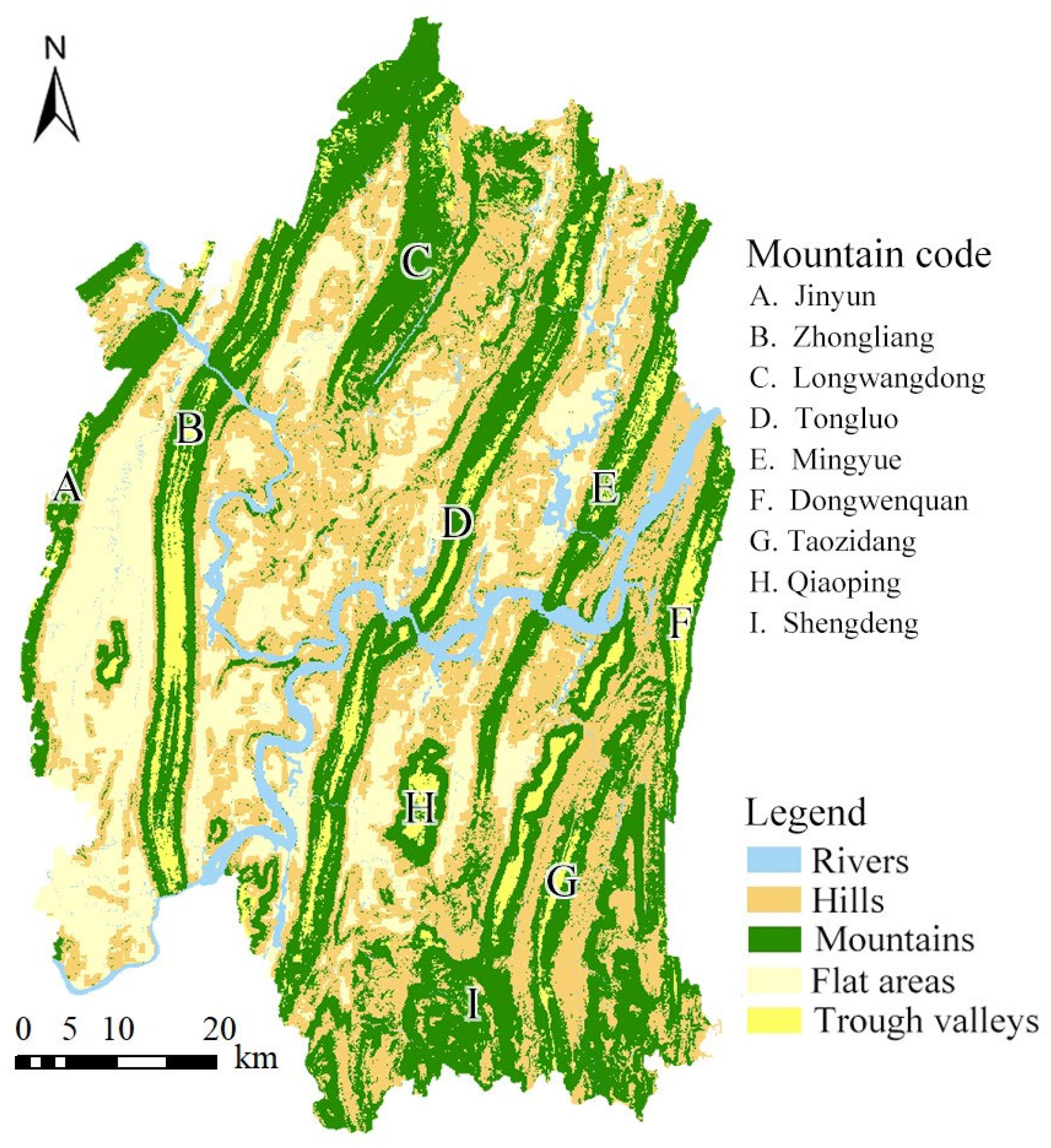
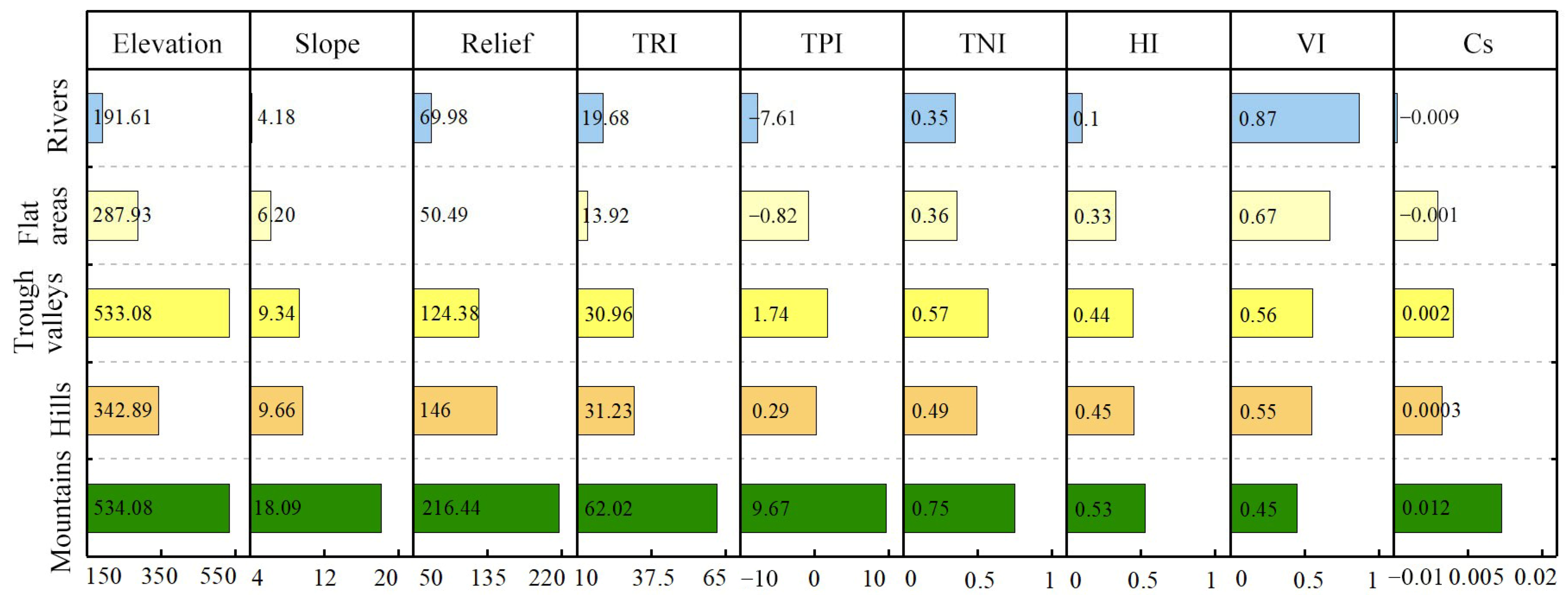
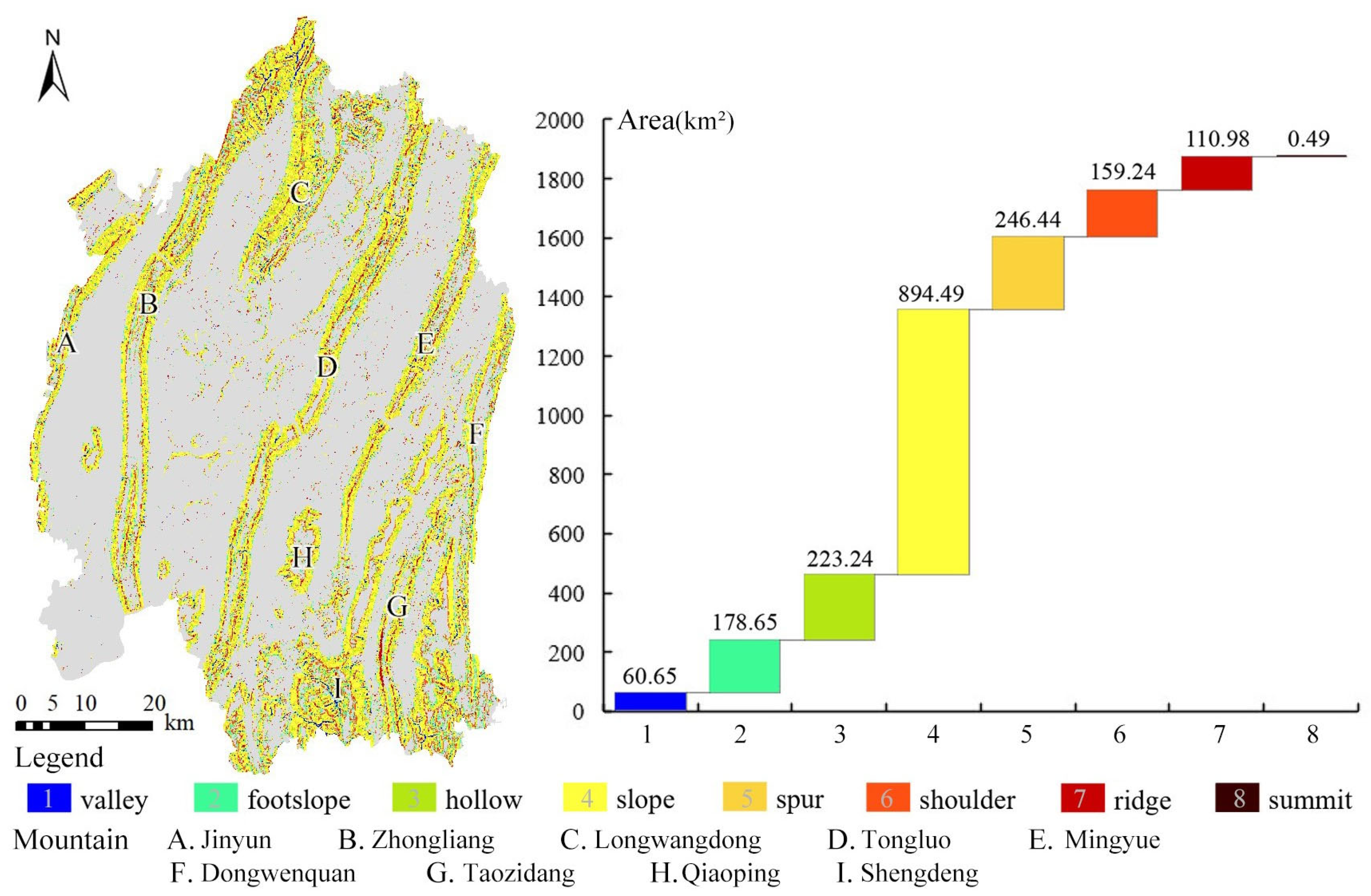

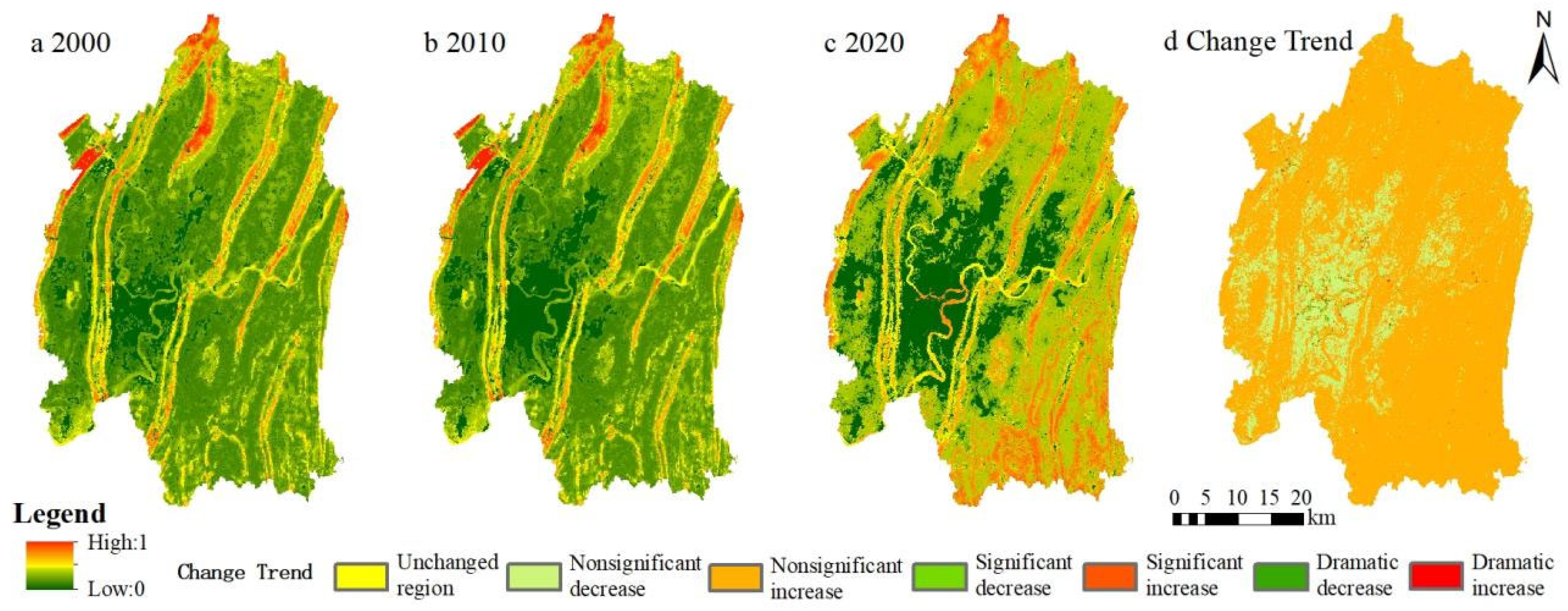

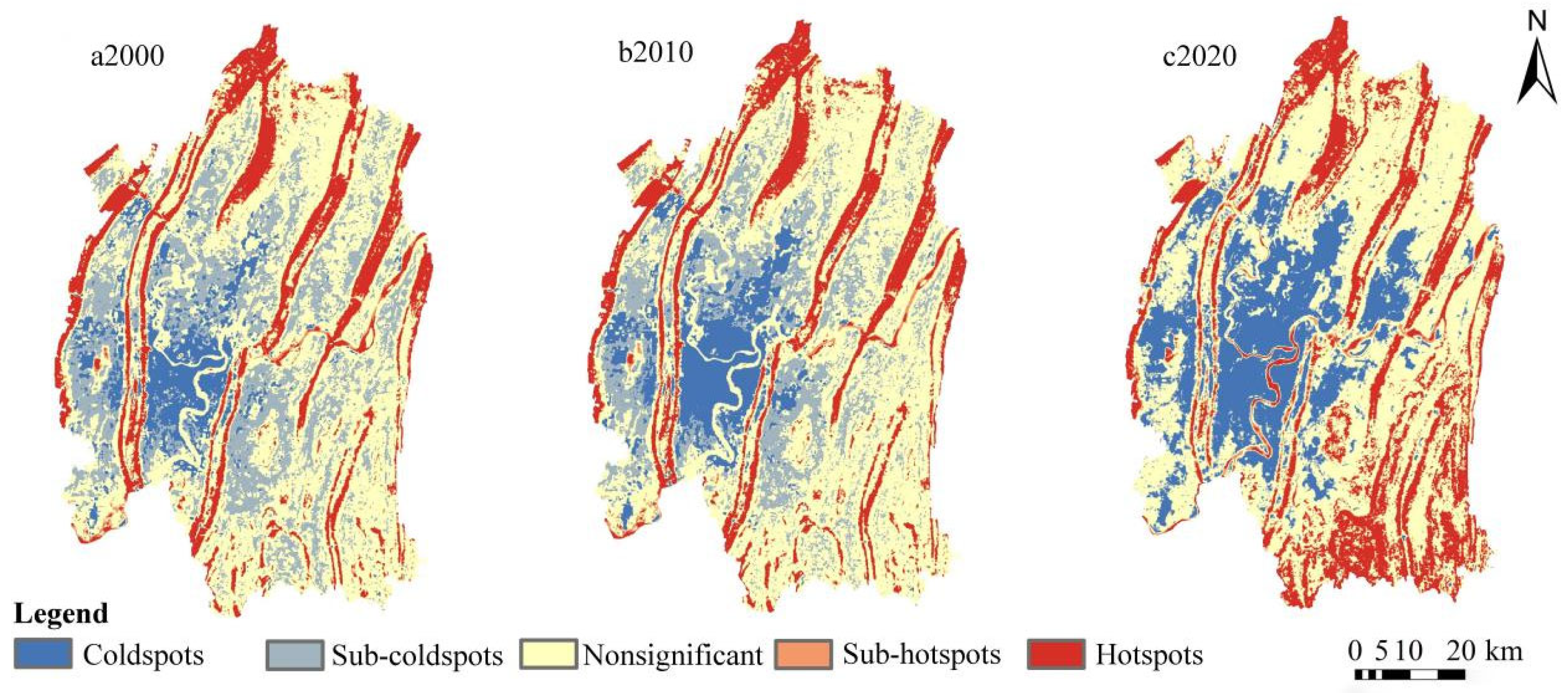







| Datasets | Data | Data Sources | Resolution | Data Processing |
|---|---|---|---|---|
| Topographic dataset | DEM, Slope, Relief, TRI, TPI, TNI, HI, VI, Cs | Geospatial Data Cloud Platform (http://www.gscloud.cn) URL (accessed on 15 September 2023) | 30 m | ASTER GDEM V2 global digital elevation model (DEM) data were obtained for Slope, Relief, TRI (terrain ruggedness index), TPI (topographic position index), TNI (terrain niche index), HI (Hill index), VI (Valley index), and Cs (Surface curvature index) extractions by SimDTA V1.0.3 software. |
| Land use dataset | Land use types | Resource and Environment Science and Data Center (http://www.resdc.cn/) URL (accessed on 15 September 2023) | 30 m | The land use type was extracted according to the scope of the study area by ArcGIS. |
| Meteorological dataset | Precipitation, Temperature, Sunshine duration | National Meteorological Information Center (http://data.cma.cn/) URL (accessed on 15 September 2023) | 30 m | According to the daily dataset of surface climate data (V3.0), temperature, precipitation, and sunshine duration data were interpolated by ANUSPLIN 4.3 with data from 28 meteorological stations in the study area and its surrounding zones. |
| Vegetation dataset | NDVI, NPP | Geospatial Data Cloud Platform (http://www.gscloud.cn)URL (accessed on 20 September 2023) MODIS17 (http://files.ntsg.umt.edu) URL (accessed on 20 September 2023) | 30 m, 250 m | The normalized difference vegetation index (NDVI) was calculated based on the red and near-infrared bands of Landsat remote sensing image data. The net primary productivity (NPP) obtained from MODIS17 was resampled to 30 m resolution by cubic convolution interpolation. |
| Soil dataset | Soil types, Sand, Silt, Clay, Gravel, Organic carbon, Bulk | National Tibetan Plateau Data Center (http://data.tpdc.ac.cn/) URL (accessed on 20 September 2023) | 1 km | The soil data were extracted from the Harmonized World Soil Database v1.2 and was resampled to 30 m resolution by cubic convolution interpolation. |
| Distance factor dataset | Dis_forest, Dis_grass, Dis_cult, Dis_water, Dis_cons | Land use dataset | 30 m | Based on the land use data of 2000, 2010, and 2020, with the ArcGIS Euclidean distance tool, the distance factor layers, such as the distance to cultivated land, forestland, grassland, water area, construction land, and unused land, were calculated. |
| Socio-economic dataset | GDP, POP, NLT | Resource and Environmental Science Data Center (http://www.resdc.cn/) URL (accessed on 20 September 2023) WorldPop platform (https://www.worldpop.org/) URL (accessed on 20 September 2023) NPP-VIIRS-like NLT dataset (https://eogdata.mines.edu/)URL (accessed on 20 September 2023) | 1 km 500 m 500 m | The gross regional domestic product (GDP) was resampled to 30 m resolution by cubic convolution interpolation. The population (POP) was resampled to 30 m resolution by cubic convolution interpolation. The nighttime light (NLT) data were resampled to 30 m resolution by cubic convolution interpolation. |
| Principal Component 1 | Principal Component 2 | Principal Component 3 | Principal Component 4 | |
|---|---|---|---|---|
| Eigenvalues | 12,698.092 | 2964.815 | 518.077 | 399.506 |
| Percentage | 73.859 | 17.245 | 3.013 | 2.324 |
| Cumulative contribution | 73.859 | 91.104 | 94.117 | 96.441 |
| Principal component eigenvector | ||||
| DEM | 0.073 | 0.277 | 0.678 | 0.438 |
| Slope | 0.087 | 0.334 | −0.683 | 0.616 |
| Relief | 0.081 | 0.488 | −0.063 | −0.440 |
| TRI | 0.078 | 0.427 | −0.110 | −0.422 |
| TPI | 0.098 | −0.046 | 0.041 | 0.058 |
| TNI | 0.115 | 0.592 | 0.210 | 0.123 |
| HI | 0.684 | −0.168 | 0.064 | 0.097 |
| VI | −0.692 | 0.101 | 0.075 | 0.156 |
| Cs | 0.070 | −0.023 | 0.054 | 0.069 |
| Threats | Maximum Influence Distance (km) | Weight |
|---|---|---|
| Paddy field | 1 | 0.5 |
| Dry land | 1 | 0.5 |
| Urban land | 6 | 1 |
| Rural residential area | 3 | 0.8 |
| Industrial, mining, and transportation land | 4 | 0.9 |
| Bare land | 1 | 0.6 |
| Gross regional domestic product | 3 | 0.3 |
| Population | 2 | 0.2 |
| Land Use Type | Habitat Suitability | Paddy Field | Dry Land | Urban Land | Rural Residential Areas | Industrial, Mining and Transportation Land | Bare Land | GDP | POP |
|---|---|---|---|---|---|---|---|---|---|
| Paddy field | 0.4 | 0 | 1 | 0.5 | 0.8 | 0.6 | 0.3 | 0.3 | 0.4 |
| Dry land | 0.4 | 1 | 0 | 0.5 | 0.8 | 0.6 | 0.3 | 0.3 | 0.4 |
| Top-slope forestland | 1 | 0.35 | 0.45 | 0.7 | 0.6 | 0.7 | 0.3 | 0.3 | 0.4 |
| Mid-slope forestland | 0.95 | 0.45 | 0.55 | 0.8 | 0.7 | 0.8 | 0.35 | 0.4 | 0.5 |
| Valley forestland | 0.95 | 0.55 | 0.65 | 0.8 | 0.8 | 0.8 | 0.35 | 0.4 | 0.5 |
| Footslope forestland | 0.9 | 0.55 | 0.65 | 0.85 | 0.8 | 0.85 | 0.4 | 0.45 | 0.55 |
| Other forestland | 0.9 | 0.6 | 0.65 | 0.85 | 0.8 | 0.85 | 0.4 | 0.45 | 0.55 |
| Grassland | 0.85 | 0.6 | 0.65 | 0.85 | 0.85 | 0.85 | 0.4 | 0.45 | 0.55 |
| Rivers | 0.9 | 0.5 | 0.5 | 0.8 | 0.7 | 0.8 | 0.3 | 0.6 | 0.5 |
| Lakes | 0.9 | 0.5 | 0.5 | 0.7 | 0.8 | 0.8 | 0.3 | 0.5 | 0.5 |
| Reservoirs and ponds | 0.8 | 0.6 | 0.6 | 0.7 | 0.8 | 0.8 | 0.3 | 0.5 | 0.6 |
| Shoal | 0.8 | 0.5 | 0.5 | 0.6 | 0.6 | 0.5 | 0.4 | 0.2 | 0.2 |
| Urban land | 0 | 0 | 0 | 0 | 0 | 0 | 0 | 0 | 0 |
| Rural residential area | 0 | 0 | 0 | 0 | 0 | 0 | 0 | 0 | 0 |
| Industrial, mining, and transportation land | 0 | 0 | 0 | 0 | 0 | 0 | 0 | 0 | 0 |
| Bare land | 0 | 0 | 0 | 0 | 0 | 0 | 0 | 0 | 0 |
| Slope | F-Value | Change Trend Types |
|---|---|---|
| Slope = 0 | F < 161.448 | unchanged |
| 161.448 ≤ F < 4052.181 | ||
| F ≥ 4052.181 | ||
| Slope > 0 | F < 161.448 | nonsignificant increase |
| 161.448 ≤ F < 4052.181 | significant increase | |
| F ≥ 4052.181 | dramatic increase | |
| Slope < 0 | F < 161.448 | nonsignificant decrease |
| 161.448 ≤ F < 4052.181 | significant decrease | |
| F ≥ 4052.181 | dramatic decrease |
| Influencing Factors | VIF | Influencing Factors | VIF | Influencing Factors | VIF |
|---|---|---|---|---|---|
| Land use types | 2.05 | Temperature | >5 | Distance to cultivated land | 2.05 |
| Landform type | 1.27 | Precipitation | 1.71 | Distance to construction land | 1.77 |
| DEM | 2.35 | Rainfall erosivity index | >5 | POP | 1.60 |
| Slope | 1.74 | Reference evapotranspiration | >5 | GDP | 3.54 |
| Aspect | 1.05 | Soil types | >5 | Nighttime light | >5 |
| Relief | >5 | Erodibility | >5 | CMC overall urban planning | >5 |
| TRI | >5 | Saturated hydraulic conductivity | >5 | Multi-center groups strategies | 1.84 |
| TPI | 1.04 | Organic carbon content | 1.35 | Four parallel mountain developments and controls | 2.01 |
| TNI | 3.24 | Distance to forestland | 1.56 | Ecological function regionalization | >5 |
| NDVI | 2.99 | Distance to grassland | 1.14 | Ecological redline | 2.68 |
| NPP | 3.62 | Distance to waters | 1.23 | Beautiful landscape city planning | 2.35 |
| Parameter | Parametric Estimate | Std. Error | T-Value | p-Value |
|---|---|---|---|---|
| Intercept | −0.063560 | 0.050772 | −1.252 | 0.210631 |
| Cultivated land | 0.335495 | 0.050595 | 6.631 | 3.44 × 10−11 *** |
| Forestland | 0.507315 | 0.050666 | 10.013 | <2 × 10−16 *** |
| Grassland | 0.432428 | 0.051877 | 8.336 | <2 × 10−16 *** |
| Water areas | 0.391870 | 0.051363 | 7.629 | 2.49 × 10−14 *** |
| Construction land | 0.286391 | 0.050772 | 5.641 | 1.72 × 10−8 *** |
| Unused land | 0.369158 | 0.097053 | 3.804 | 0.000143 *** |
| Flat areas | −0.010782 | 0.006663 | −1.618 | 0.105640 |
| Top-slope | 0.101374 | 0.008469 | 11.969 | <2 × 10−16 *** |
| Mid-slope | 0.129301 | 0.005969 | 21.663 | <2 × 10−16 *** |
| Footslope | 0.102275 | 0.007488 | 13.658 | <2 × 10−16 *** |
| Hills | 0.031711 | 0.012185 | 2.602 | 0.009265 ** |
| Trough valley | −0.032755 | 0.005250 | −6.239 | 4.51 × 10−10 *** |
| River way | 0.102973 | 0.018745 | 5.493 | 4.00 × 10−8 *** |
| Multi-center groups strategies | −0.146346 | 0.017455 | −8.384 | <2 × 10−16 *** |
| Four parallel mountains’ developments and controls | 0.054770 | 0.048296 | 1.134 | 0.000212 *** |
| Ecological redlines | 0.056627 | 0.004662 | 12.146 | <2 × 10−16 *** |
| Beautiful landscape city planning | 0.036629 | 0.004539 | 8.070 | 7.51 × 10−16 *** |
| Smooth terms | Estimated degree of freedom | Reference degree of freedom | F-value | p-value |
| s(DEM) | 7.953 | 9.042 | 9.540 | <2 × 10−16 *** |
| s(Slope) | 1.284 | 1.518 | 0.414 | 0.733 |
| s(Aspect) | 4.716 | 5.610 | 1.817 | 0.099 |
| s(TPI) | 2.000 | 2.320 | 48.748 | <2 × 10−16 *** |
| s(TNI) | 3.463 | 3.846 | 22.377 | <2 × 10−16 *** |
| s(NDVI) | 1.989 | 2.000 | 172.510 | <2 × 10−16 *** |
| s(NPP) | 2.971 | 2.999 | 120.121 | <2 × 10−16 *** |
| s(Pre) | 4.643 | 4.945 | 45.655 | <2 × 10−16 *** |
| s(OC) | 2.950 | 2.998 | 36.371 | <2 × 10−16 *** |
| s(Dis_forest) | 2.986 | 3.000 | 159.328 | <2 × 10−16 *** |
| s(Dis_grass) | 1.979 | 2.000 | 25.845 | <2 × 10−16 *** |
| s(Dis_cult) | 7.814 | 7.987 | 73.608 | <2 × 10−16 *** |
| s(Dis_water) | 3.833 | 4.442 | 5.814 | 8.57 × 10−5 *** |
| s(Dis_cons) | 2.892 | 3.000 | 114.695 | <2 × 10−16 *** |
| s(POP) | 2.707 | 2.941 | 17.746 | <2 × 10−16 *** |
| s(GDP) | 2.832 | 2.980 | 15.490 | <2 × 10−16 *** |
Disclaimer/Publisher’s Note: The statements, opinions and data contained in all publications are solely those of the individual author(s) and contributor(s) and not of MDPI and/or the editor(s). MDPI and/or the editor(s) disclaim responsibility for any injury to people or property resulting from any ideas, methods, instructions or products referred to in the content. |
© 2025 by the authors. Licensee MDPI, Basel, Switzerland. This article is an open access article distributed under the terms and conditions of the Creative Commons Attribution (CC BY) license (https://creativecommons.org/licenses/by/4.0/).
Share and Cite
Wang, F.; Li, Z.; Li, X.; Li, Z.; Qi, G.; Wang, Q. Considering Mountain Micro-Topographic Characteristics in Habitat Quality Assessments and Its Nonlinear Influencing Mechanism. Sustainability 2025, 17, 1515. https://doi.org/10.3390/su17041515
Wang F, Li Z, Li X, Li Z, Qi G, Wang Q. Considering Mountain Micro-Topographic Characteristics in Habitat Quality Assessments and Its Nonlinear Influencing Mechanism. Sustainability. 2025; 17(4):1515. https://doi.org/10.3390/su17041515
Chicago/Turabian StyleWang, Fang, Zhe Li, Xiaoya Li, Zhaoyu Li, Guangxiang Qi, and Qi Wang. 2025. "Considering Mountain Micro-Topographic Characteristics in Habitat Quality Assessments and Its Nonlinear Influencing Mechanism" Sustainability 17, no. 4: 1515. https://doi.org/10.3390/su17041515
APA StyleWang, F., Li, Z., Li, X., Li, Z., Qi, G., & Wang, Q. (2025). Considering Mountain Micro-Topographic Characteristics in Habitat Quality Assessments and Its Nonlinear Influencing Mechanism. Sustainability, 17(4), 1515. https://doi.org/10.3390/su17041515







